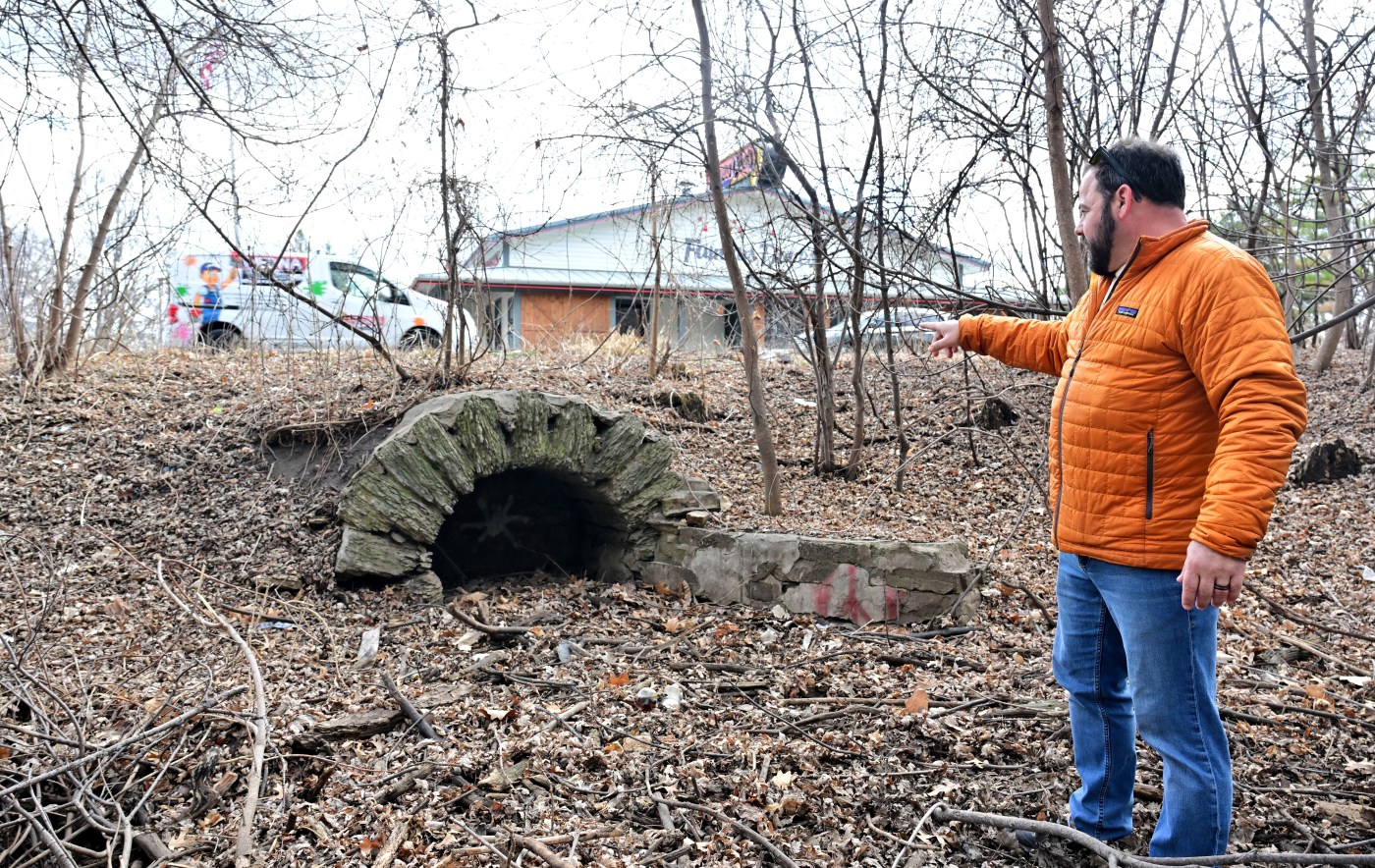
A geologist and a civil engineer found a prehistoric creek in St. Paul. Now they want to restore it.
Charlie Evans stands within the wooded ravine beneath the short bridge that links Edgcumbe Road to Hamline Avenue in St. Paul and excitedly points to limestone remnants of old Works Progress Administration projects from the 1930s.
There sits a staircase, and over there, the outlets and inlets from a century-old municipal swimming hole. A driver on the road above, or a golfer across the street at Highland National Golf Course, would see little more than trees emerging from the recessed earth.
St. Paul civil engineer Charlie Evans. (John Autey / Pioneer Press)
With his training as a civil engineer, Evans spots evidence of what had been a shallow, man-made pool installed around the same time as Montreal Road was extended to West Seventh Street in 1927. On the same natural corridor sat a replacement pool from 1936, running along what is now the muddy trail of an obscure, almost dried-out creek bed to the limestone walls of the boarded-up chlorine building and the long-shuttered Highland Bath House beyond it.
A century ago, St. Paul’s youth splashed in the non-chlorinated groundwater of Highland Lake, a now-defunct municipal pool that ran 100 feet wide and 500 feet long, fed in part by stormwater and a prehistoric creek so small it goes unnamed on historical maps. Evans, a sixth-generation St. Paul resident who can trace his ancestry to the state’s territorial pioneers, has family members who once dipped their toes in those long-gone swimming holes.
“When the WPA did the (1936) pool, at the same time they landscaped the ravine, erecting four foot bridges and 12 waterfalls to help with erosion control,” said Evans, a longtime city employee. “It was a quarter-mile of landscaping in the ravine.”
Highland Creek
Today, you can’t fish from Highland Creek, swim in Highland Creek or even see Highland Creek from a few dozen yards away.
But working with hydrogeologist Greg Brick, Evans is convinced that the creek was once the highest-volume stream in the city, running larger than Phalen Creek or Trout Brook in centuries past. And with less effort than some might suspect, he believes a sizable stretch of the creek could rise again, restored someday by diverted stormwater and the work of like-minded naturalists.
”Highland Creek is now the smallest creek in the city, but it was once the longest,” said Brick, during a recent spelunk through its wooded ravines.
Small ponds and low points on Highland National Golf Course mark the one-time path of Highland Creek in St. Paul on Friday, March 15, 2024. (John Autey / Pioneer Press)
Daylighting a prehistoric creek would be no small undertaking, but why stop there?
Evans sees Highland Creek as just the first phase. The Historic Highland Lake could, in theory, return as a municipal swim pond in the same vein as the swim pond at Lake Elmo.
“If that happened, the city could reopen the Historic Bath House back into an actual bath house again,” he said. “That would be incredible.”
Where it runs
The two men believe the prehistoric creek runs a mile and a half, beginning in a former wetland near the north edge of the Highland National Golf Course. It flowed south through a shallow ravine that is still in evidence as a chain of ponds on the golf course, according to Brick, who believes it crossed under what is now Hamline Avenue around the 18th hole.
That’s where it met the tree-lined ravine at Beechwood Avenue and ran under Edgcumbe Bridge into what had been the Highland Pool. At the pool’s south end, the water found a buried pipe that runs under Circus Juventas, allowing it to emerge in the ravine across West Seventh Street/Fort Road from Mickey’s Diner.
A stone culvert carried the water under the road and into a lower ravine in what’s known on city maps as the Kipps Glen Terrace Addition. Based on Brick’s observations, the 100-foot ravine was likely carved some 10,000 to 12,000 years ago by what Evans describes as a “biblical flood.” Today, the wooded land hosts the last naturally “daylighted” — or above-ground — sections of the creek in Highland Park, though a long-legged adult could likely make it across the sliver of water in one jump.
From there, Highland Creek flowed under the railway trestle of the old Ford spur, the sidetrack that led to the Ford Motor Co.’s auto manufacturing plant in Highland Park. And from there, said Brick, the creek traveled through a sandstone gorge to the Mississippi River bottomlands, where Lake Crosby drained into it.
St. Paul civil engineer Charlie Evans points out Highland Creek on a hydrological map while at Highland National Golf Course St. Paul on Friday, March 15, 2024. (John Autey / Pioneer Press)
Daylighting long-hidden waters
Evans, who has broached the topic with St. Paul Public Works officials, said he’s well aware that St. Paul Parks and Recreation has no money handy for such a project. Still, the Capitol Region Watershed District and similar organizations have put energy into restoring long-lost creeks before, including daylighting long-hidden portions of Lower Phalen Creek.
”This is all within park boundaries,” Evans said. “They don’t have to acquire it. They already own it.”
It took years of advocacy, but the Lower Phalen Creek Project evolved into its own nonprofit, which has led planning and fundraising for the Wakan Tipi Center, an interpretative center that will be located just east of downtown St. Paul.
For now, Evans and Brick are happy to celebrate a slice of St. Paul long forgotten.
The Highland Park Aquatic Center was built south of Montreal Avenue in 1976, turning the old pool into surplus property. It’s unclear when the old pool was removed, but Evans, who played frisbee golf in high school just above the Hamline/Edgcumbe intersection, said it was already gone when he was a student in the 1990s, relegating it to the stuff of city lore.
Related Articles
Joe Soucheray: Reckless car thieves, streetlamp wreckers … we’re tired of this
St. Paul mother gives emotional statement before sentencing for daughter’s fentanyl death
Third suspect charged in weekend shootout outside Cub Foods store on St. Paul’s East Side
Central High softball players exceed initial fundraising goal to visit vice president in D.C.
St. Paul seeks design, engineering experts to advance River Learning Center in Hidden Falls

